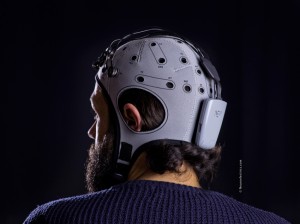Last week I had the chance of training a student group on Computational Intelligence and Machine Learning for EEG data analysis at the Petronas Technology University in Malaysia. As usual, being in direct contact with the research offspring is a very interesting experience. It looks like EEG monitoring is booming in Asia and I could find a sample there. For instance, you might have already seen the entertainment application (to say the least) for moving your ears or tail depending on your mood. I would say the cherry on the top are the EEG acquisition devices that work wireless and with dry electrodes like our dear Enobio because of its user friendliness. I think there is a long tradition of monitoring physiological variables in Asian countries mostly for human-machine interaction applications. The visionary transition from industrial automation, for which Japan developed pioneering systems, to robotic domestic assistants might be behind this love for physiological measures.
The assistants to the training event, who covered all levels from masters to post-doc students, are working in several applications which aren’t really so different (as expected) from what we are pursuing in Europe thanks to research globalization and modern extended availability of data sets and scientific publications. However, I found two interesting topics came up, namely the comparison of the effects of 3D displays with respect to 2D ones, and the characterization of distraction events in drivers. Both were based on high-resolution 128 channel recording systems. Other applications I was confronted with were more typical: brain-computer interface based on motor imagery, drowsiness detection in drivers, fMRI and EEG fusion for medical applications, detection and correction of balistographic artifacts in EEG, event-related potentials, characterization of memory and attention on hand of EEG, and epileptic seizure detection (sorry guys if I am forgetting any of you!). These brilliant students are trying to get the most out of EEG data. And they know correct computational intelligence and machine learning are the best companions for this adventure, so they showed great engagement in the training sessions.
I think such topics are still poorly covered in university curricula (at least it used to be 4 years ago, when I was lecturing at a Catalan university). It is really a pity, since these are the kind of techniques necessary for developing real-world applications. These are basically based on making some decisions when the system is confronted with incoming data. The mapping between the measurement space gathered by the sensors and the output decision space is precisely the target of computational intelligence, machine learning, and pattern recognition.
I would say the two topics that raised the audience’s interest the most were feature selection and classification techniques. In the first case we discussed the two different types of feature selection techniques (parametric and non-parametric) and described in detail the application of genetic algorithms for the selection of EEG features. I mentioned two examples we have implemented at Starlab. The first one deals with a motor imagery application, for which we have applied a wavelet transformation and then select the wavelet coefficients depending on their classification performance. Hence this performance is used as a fitness function for driving the evolutionary search process. We have used this same strategy in the second example I commented. In this case we have selected among complex network features as extracted after applying synchronicity likelihood.
On the other hand classification specially caught the attention of the training sessions’ participants. We went through supervised and unsupervised algorithms, and explained how to transform the result of an unsupervised method for delivering a labelled output. Linear Discriminant Analysis, k-Nearest Neighbours, Decision Trees, Support Vector Machines, and different types of Classifier Ensembles were covered in the supervised realm. All in all I think the attendants got for a week a great overview of the different techniques and procedures you can use to develop a real-world application. I was very satisfied with the result. Moreover, the questions and suggestions of the attendants in the last 2 day sessions, when we discussed their personal projects, made me feel they have got the essence of what it means to develop such a system.
Thanks to everybody for your reception, interest, and engagement. I would like to specially thank Ivan Chang, who accompanied me all throughout my Malaysian stay and make it a very pleasant experience. Thanks for your patience and friendliness.


